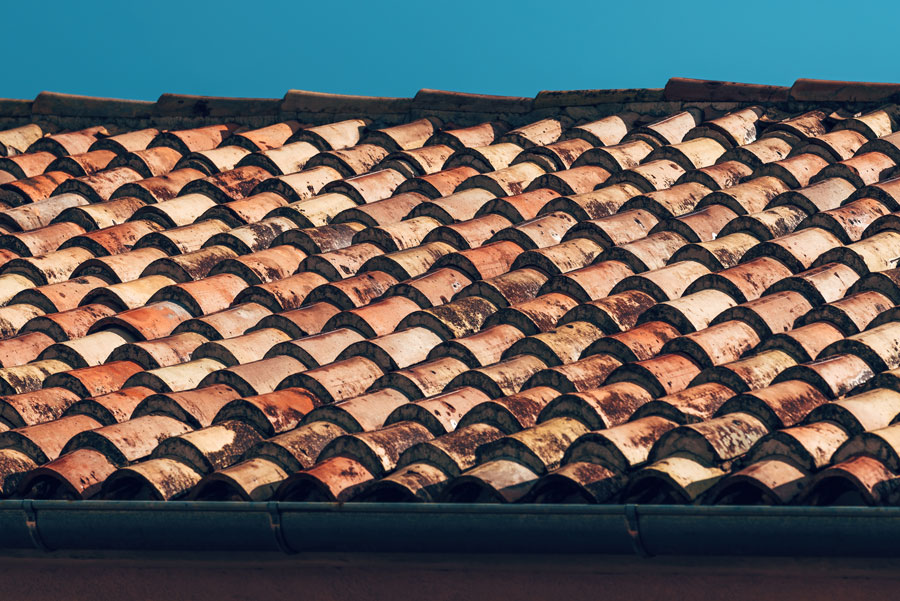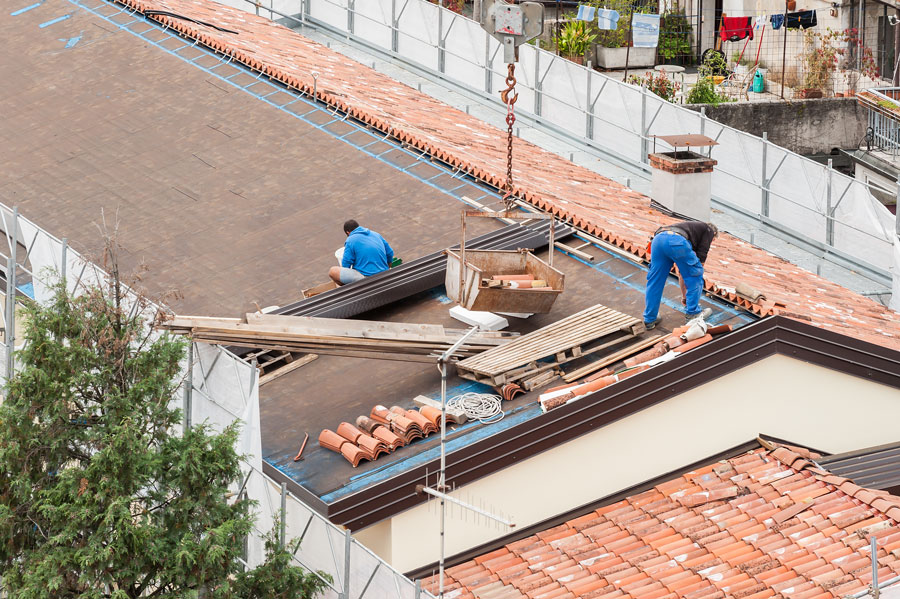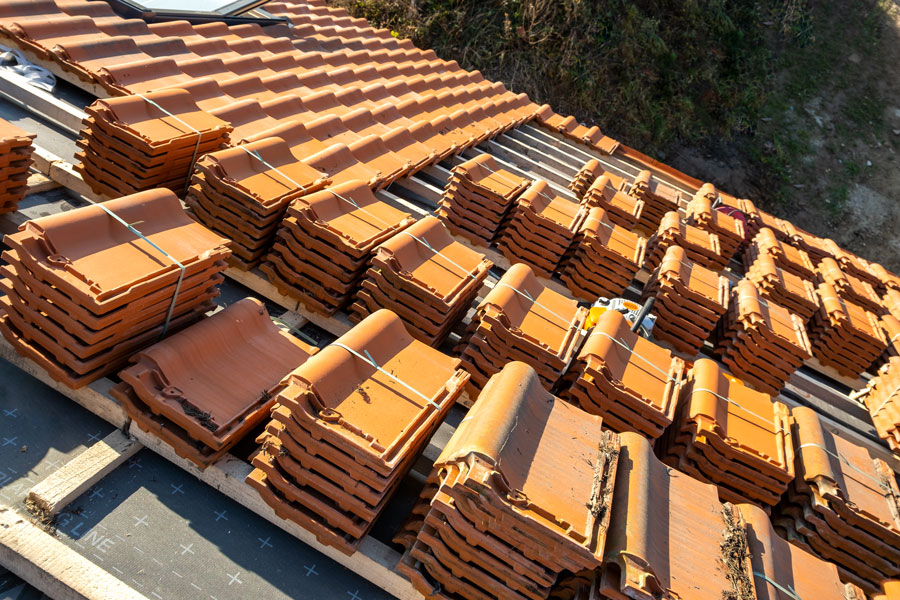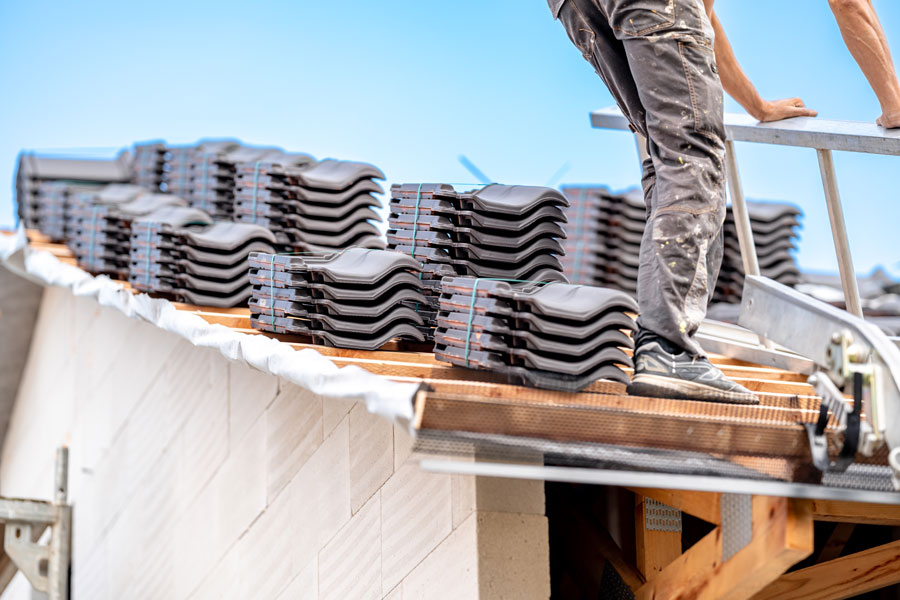- Serving London and surrounding areas
- Work for us

Tile roofs represent one of the smartest long-term investments homeowners in London can make, but how long do they actually last? The answer might surprise you: anywhere from 50 to over 100 years, depending on crucial factors that many property owners overlook.
Clay tiles can endure 60–100+ years, while concrete tiles typically last 50–75 years, and natural slate often exceeds a century. Yet London’s unpredictable climate, with relentless rain, freeze-thaw cycles, and strong winds, can dramatically impact these timelines.
This article reveals the key factors that determine your tile roof’s lifespan, from material selection to installation quality. Discover proven maintenance strategies that can add decades to your roof’s lifespan.
Learn the warning signs that signal replacement needs and expert tips tailored for London’s challenging weather conditions.

Different tile materials offer varying levels of durability and performance in London’s unique climate.
Clay tiles are among the most durable tile roofing materials in London materials, potentially lasting 60–100+ years when properly maintained. Their exceptional resistance to rot, insects, and pollution makes them ideal for urban environments. Some historical clay roofs in Europe have even surpassed the 150-year mark, demonstrating remarkable longevity.
Concrete tiles provide a more economical option, generally lasting 50–75 years in the best conditions. While less expensive than clay, they’re more susceptible to damage from freeze-thaw cycles common in London winters. Their porous nature means they absorb moisture more readily, potentially leading to moss buildup and structural weakening over time.
Natural slate tiles represent the pinnacle of durability, often exceeding 100 years and sometimes lasting 80–150 years. High-grade Welsh or Cornish slate absorbs almost no water, making it highly resistant to frost and algae growth. This premium material offers excellent fire resistance and has a naturally low environmental impact.
Composite or synthetic tiles typically last 20–60 years, depending on manufacturing quality and material composition. While these modern alternatives offer cost savings, they don’t match the longevity of traditional materials.

Several key elements determine how long your tile roof will serve your London property.
The type of tile you choose fundamentally affects longevity expectations for your roof. Clay tiles fired at high temperatures resist cracking, warping, and erosion exceptionally well, especially in variable climates.
Their inherent resilience to extreme temperatures, sunlight, and chemical reactions helps them maintain strength and appearance for decades. These tiles age gracefully, often developing a natural patina that enhances aesthetic appeal.
Concrete tiles offer consistency in quality and are easier to produce than clay alternatives. By the 1960s, concrete tiles appeared in larger formats that were more regular in size and shape, making them simpler to fix on roofs.
However, their porous nature requires periodic sealing or painting to maintain appearance and structural integrity.
Natural slate provides exceptional water resistance and durability, though it requires specialist handling due to its susceptibility to cracking under concentrated weight. High-grade slate roofing in London offers a timeless quality that adds significant property value.
Even premium materials fail prematurely when installed incorrectly. Correct tile alignment ensures water flows properly off the roof surface without pooling. Secure fastenings prevent tiles from slipping or being dislodged during storms, which is particularly important in high-wind regions. Proper underlayment installation protects the roof deck from moisture infiltration.
Flashing installation around chimneys, vents, and skylights requires precise workmanship to prevent water tracking behind these vulnerable areas. Adequate attic ventilation helps prevent moisture buildup and condensation that can compromise both tiles and underlying structures.
Regular upkeep significantly extends tile roof lifespan in London’s challenging climate. Scheduling inspections at least twice annually, in spring and autumn, helps identify issues before they escalate.
Cleaning gutters prevents water backup that can saturate eaves and accelerate decay. Removing moss and algae every 12–18 months prevents moisture pockets that compromise tile integrity.
Promptly replacing damaged or loose tiles prevents leaks and more extensive structural damage. Even minor cracks or slipped tiles should be addressed immediately to maintain the roof’s watertight seal.
London’s climate presents specific challenges for tile roofs. Rain and moisture are constant factors that can accelerate wear, encourage moss growth, and block gutters. The city’s frequent rainfall means tiles must resist moisture absorption to prevent deterioration. Temperature fluctuations cause expansion and contraction that can crack or loosen tiles over time.
Wind is particularly problematic, as strong gusts can dislodge tiles or damage flashings. Coastal properties exposed to salt spray or areas experiencing heavy freeze-thaw cycles typically see the lower end of lifespan ranges. Pollution from urban air can contribute to tile degradation, though clay tiles show strong resistance to acid rain.
Proper architectural design supports tile longevity. Adequate roof slope ensures water drains efficiently rather than pooling on the surface. Well-designed drainage channels direct water away from vulnerable areas like valleys where slipped tiles often hide. Effective ventilation in loft spaces prevents damp accumulation that shortens tile lifespan.

Proactive maintenance practices protect your roofing investment for decades.
Professional tile roof installation in London should be followed by systematic monitoring. Inspect your roof at least twice yearly, in spring and autumn, and always after major storms.
Look for cracked, slipped, or missing tiles that compromise waterproofing. Check for degrading mortar, especially around ridge and hip areas where wind uplift is most likely.
Hire specialists for biennial checks, as some issues like slipped tiles in valleys are difficult to spot from ground level. Free inspections are often available from qualified contractors across London.
Debris accumulation accelerates tile deterioration in London’s damp climate. Clear leaves, branches, moss, and algae regularly to prevent moisture trapping. Avoid high-pressure washing, which can damage tiles and their protective glazes. Instead, use gentle brushing or biocide treatments that preserve tile integrity.
Hose down or soft-wash surfaces annually using gentle approaches that don’t compromise tile structure. Remove overhanging branches to prevent leaf litter accumulation that traps moisture.
Adequate airflow protects both tiles and underlying structures. Good ventilation in the attic prevents moisture buildup and condensation that can damage roof structures and tiles. Poor airflow traps damp, shortening the lifespan of all tile types but particularly affecting concrete tiles.
Well-ventilated loft spaces also contribute to energy efficiency by regulating indoor temperatures. This thermal management reduces stress on tiles from extreme temperature fluctuations.
Quick action on minor issues prevents major expenses. Fix cracked tiles, loose flashings, or small leaks immediately before they escalate. Even hairline cracks in concrete tiles should be addressed early through annual inspections. Check fixings every five years, especially in high-wind regions where additional tile weight stresses nails and clips.
Ensure flashing around chimneys remains intact, as water tracking behind lead is a common problem in older roofs. Replace frost-damaged tiles in northern areas where they may become brittle after decades.
Different seasons require specific attention for optimal roof care. Autumn maintenance includes cleaning gutters quarterly to prevent blocked outlets that saturate eaves. Trim overhanging branches before winter storms. Inspect ridge tiles and flashing for damage before severe weather arrives.
Spring checks assess winter damage, particularly frost-related tile cracking. Remove moss and algae that accumulated during wetter months. Inspect chimneys, vents, and skylight seals for compromised waterproofing.
Expert services ensure professional roofing solutions in London meet industry standards. Hire qualified roofers for inspections, repairs, or cleaning beyond basic debris removal.
Use experienced contractors familiar with London building regulations and local climate challenges. Repoint ridge and hip mortar every 10–15 years to prevent wind uplift and maintain structural integrity.
Schedule specialist checks for slate roofs, as these materials require specific expertise. Professional care ensures compliance with building regulations and maintains warranty coverage.
Recognizing replacement indicators helps prevent catastrophic failures and water damage.
Visible damage indicates compromised roof integrity. Missing or broken tiles create bald spots or gaps that increase water ingress risk dramatically. Multiple damaged areas suggest widespread deterioration requiring full replacement rather than piecemeal repairs.
Granule loss, particularly noticeable in gutters, indicates significant wear on tile surfaces. Excessive moss or algae growth that persists despite cleaning can lift tiles and trap moisture beneath them.
Damaged flashing with rust or cracks compromises waterproofing around vulnerable areas. Once flashing fails, water infiltrates roof structures regardless of tile condition.
Internal indicators often reveal problems invisible from the outside. Water stains or leaks appearing as damp patches or drips on ceilings indicate penetration through the roofing system. Even minor stains suggest failing waterproofing that will worsen over time.
Musty smells persisting in the attic point to moisture accumulation or mold growth. These odors indicate that humidity is compromising structural elements beneath tiles.
Daylight visible in the attic through the roof boards signals gaps in the roofing system. Light penetration means water can also enter during rainfall.
Serious structural indicators demand immediate professional assessment. Sagging rooflines indicate structural damage from prolonged moisture exposure or excessive weight stress. This deformation suggests compromised support beams requiring urgent attention.
Age considerations matter significantly; roofs over 20–25 years old with multiple minor damages often cost more to repeatedly repair than replace. Increased energy bills may result from poor insulation or damage, reducing heating and cooling efficiency.
Inspect your tile roof at least twice yearly, ideally in spring and autumn, and always after major storms. These seasonal checks help identify damage from winter weather and prepare the roof for upcoming seasonal challenges. Professional inspections every three to five years ensure underlying components like underlayment remain functional.
Walking on tile roofs should be avoided where possible, as slate can crack under concentrated weight. When roof access is necessary, professionals use proper equipment and techniques to distribute weight safely. For routine maintenance like gutter cleaning, work from ladders rather than stepping directly on tiles to prevent damage.
Concrete tiles typically last 50–75 years compared to clay tiles’ 60–100+ year lifespan in London conditions. Clay’s superior resistance to moisture absorption, freeze-thaw cycles, and temperature extremes gives it longer durability. Concrete requires more frequent maintenance, including periodic sealing, to achieve maximum lifespan.
Regular moss and algae removal every 12–18 months prevents moisture pockets that compromise tiles. Keeping gutters clear quarterly prevents water backup that saturates eaves. Promptly replacing cracked or slipped tiles maintains waterproofing integrity. Ensuring proper attic ventilation prevents condensation damage to both tiles and underlying structures.
Tile roofs in London offer exceptional longevity when properly maintained, with clay and slate options providing century-long service. Understanding material differences, maintaining regular inspection schedules, and addressing repairs promptly maximizes your roof’s lifespan.
London’s challenging climate requires proactive care, including seasonal maintenance, professional inspections, and proper ventilation. Recognizing replacement signs prevents costly water damage and structural issues.
Whether choosing clay, concrete, or slate tiles, quality installation and consistent upkeep ensure your roof protects your property for generations.
Monday to Sunday: 6:00 AM – 8:00 PM (Open Daily)
Subscribe to our newsletter for the latest updates and offers.
© [2010 [A&A Roofing]. All Rights Reserved. Designed By Spectrum Media Solutions.